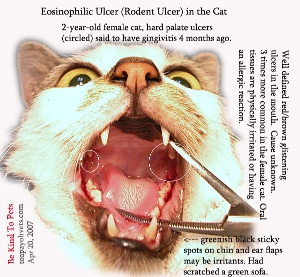Eosinophilic ulcer (Rodent ulcer) in the cat is an old disease
affecting all cats of all ages and breeds. The cause remains
unknown. There is a large increase of eosinophils in the blood.
Now, most cat owners in Singapore just want the cat to be cured
and be normal.
However this condition may recur. The owner then thinks that the
veterinarian is no good. The drugs cause the cat to be hungry
but will resolve the problem for a time.
In eosinophilic ulcer cases, it is best to monitor the "owner"
weekly by asking the owner to examine the mouth. If the ulcer
has healed, there is still a need to monitor the "owner" as the
condition will recur. The ulcers come back big and red. Painful
mouth. Not eating. The owner loses confidence in the
veterinarian as the disease comes back again and again, costing
the owner money and time.
 2-YEAR-OLD
FEMALE CAT 2-YEAR-OLD
FEMALE CAT
Usual complaints are loss of appetite, being unfriendly and
having bad breadth or salivation. The cat hisses and scratches
if the vet opens his or her mouth.
In the above case, the cat had been diagnosed gingivitis
around 4 months ago by a veterinarian. The cat had been an
"unfriendly" cat for some time. After the injection and
antibiotic treatment from the veterinarian for gingivitis, she
permitted handling to clean up her claws (dirtied by scratching
the green sofa) for a while. After that she became angry when
her head area was touched.
She hissed and pawed at the consultation table when I tried to
open her mouth. A tranquiliser injection into the back muscle
would be needed, but this cat was experienced in the sense that
the other veterinarian had tranquilised her before.
Now, very few veterinary assistants have strong grips. I know
that Anna would react to sudden pawing as she had been scratched
by cats before. It would be a reflex reaction as the cat
struggled. She might release the cat and we would have a
problem.
"Put her inside the cat and restrain with the loop," I said. As
I injected, the cat sprang forward. So, she received half dose.
What to do? The cat could still scratch. She might leap
off the operating table and suffer fractures.
"Wrap her in a big thick towel and give some anaesthetic gas," I
said. The gas was effective to permit opening of her mouth.
There were two reddish brown glistening ulcers and gingivitis.
The blood oozed out from the mouth.
"Was there anything that irritated the mouth, stressed the cat
or cause allergy?" I asked the owner. The young thin man in his
twenties could not think of any event. Normally cats have clean
chins and sides of the mouth. This cat had greenish-black spots
as if some sticky stuff had been greased into the hairs.
All sticky stuff were removed. The ears were cleaned and
irrigated. Teeth scaling was done but the mild gingivitis was
not the likely cause of irritation. After a long period of
asking, the owner remember that he had a green sofa and that the
cat would use it as a scratching post. There was another cat at
home but this spayed cat could not get along with him.
The owner was asked to come one month later. I needed to get a
reminder system up to remind him. I don't remind owners for
follow ups as they may misconstrue as soliciting for business.
Sometimes, in the interest of the pet, one needs to be
solicitous about the health of the cat, in diseases such as
feline eosinophilic ulcers which tend to recur. |